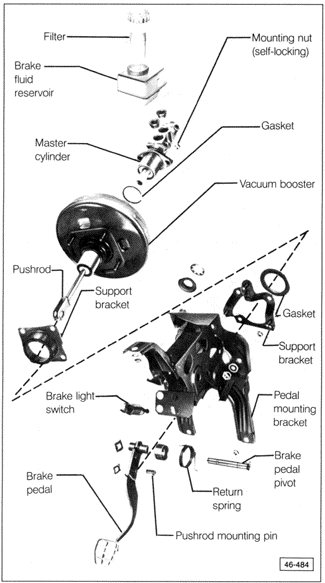4.4 Master Cylinder and Vacuum BoosterThe master cylinder, its vacuum booster, and the brake pedal assembly are shown in Fig. 4-2. The vacuum booster and master cylinder are mounted to the firewall in the engine compartment. The pedal operates the master cylinder via a pushrod which passes through the firewall. The master cylinder piston acts on the brake fluid to create pressure in the system. The brake fluid reservoir is mounted atop the master cylinder. The vacuum booster, mounted between the pedal mechanism and the master cylinder, uses the difference between engine vacuum and atmospheric pressure to help actuate the master cylinder and reduce pedal effort. Diesel engines, because of their very low engine vacuum, are equipped with an auxiliary vacuum pump. When the engine is running, vacuum is applied equally to both sides of the booster diaphragm. When the brake pedal is pressed, atmospheric pressure reaches the pedal side of the diaphragm and creates the brake-boosting pressure differential. A check valve in the vacuum hose holds vacuum in the booster when the engine is stopped. The pedal pushrod is directly connected to the master cylinder so that a failure of the vacuum booster, although it will increase braking effort, will not result in total brake failure.

|